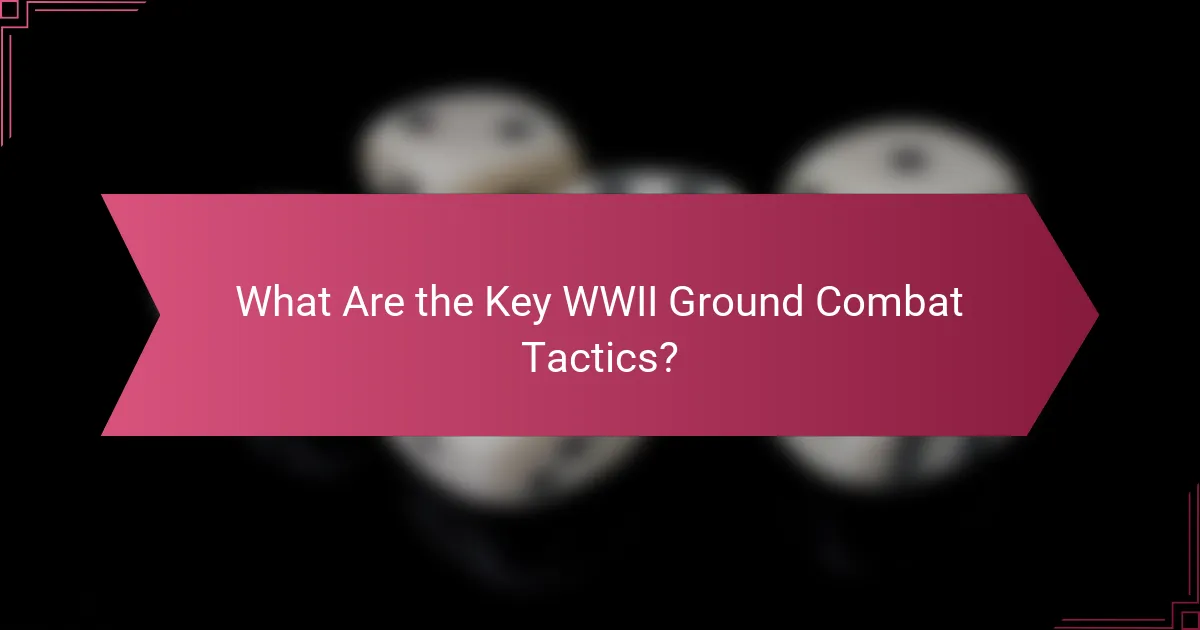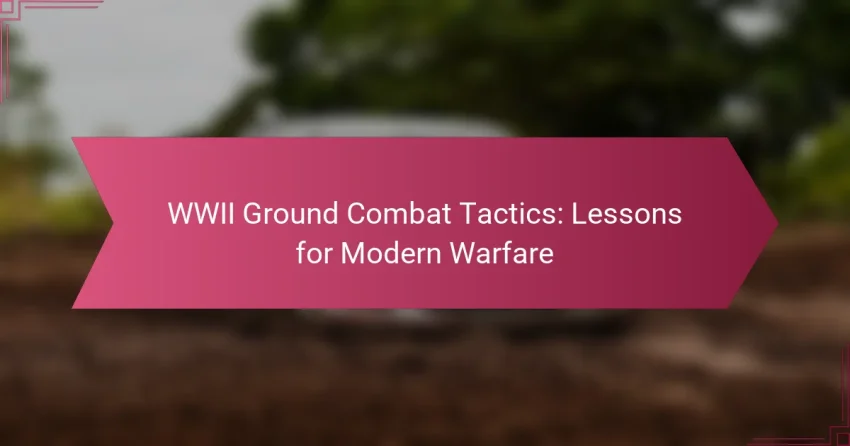The ground combat tactics developed during World War II, such as combined arms operations and blitzkrieg strategies, have left a lasting impact on modern military practices. Emphasizing coordination, speed, and adaptability, these strategies continue to inform contemporary warfare, highlighting the importance of effective command structures and technological integration. By studying these historical lessons, modern forces can enhance their operational effectiveness and respond more adeptly to evolving combat scenarios.

What Are the Key WWII Ground Combat Tactics?
Key WWII ground combat tactics include combined arms operations, blitzkrieg strategies, defensive positions, and urban warfare techniques. These tactics emphasized coordination, speed, and adaptability, providing valuable lessons for modern military engagements.
Combined Arms Operations
Combined arms operations involve the integration of different military branches—infantry, armor, and artillery—to achieve a cohesive combat strategy. This approach allows forces to exploit the strengths of each unit while compensating for their weaknesses, enhancing overall effectiveness on the battlefield.
For example, infantry can provide cover for advancing tanks, while artillery can suppress enemy positions before an assault. Successful combined arms tactics require thorough planning and communication to ensure all units work in unison, avoiding friendly fire and maximizing impact.
Blitzkrieg Strategy
Blitzkrieg, or “lightning war,” is characterized by rapid, surprise attacks that aim to overwhelm the enemy quickly. This strategy relies on speed, mobility, and concentrated firepower to disrupt and disorient opposing forces, often leading to swift victories.
Modern applications of blitzkrieg principles emphasize the use of mechanized units and air support to penetrate enemy lines. Key considerations include maintaining momentum and ensuring supply lines remain intact to sustain operations. However, overextension can lead to vulnerabilities, so careful logistical planning is essential.
Defensive Positions
Defensive positions are strategically chosen locations where forces can prepare for and withstand enemy attacks. Effective defensive tactics involve utilizing terrain features, establishing fortifications, and coordinating fire support to create a stronghold against assaults.
Common pitfalls include over-reliance on static defenses, which can be bypassed by mobile enemy forces. A balanced approach often includes fallback positions and counterattack plans to regain lost ground if necessary. Regular drills and assessments help maintain readiness and adaptability in defensive operations.
Urban Warfare Techniques
Urban warfare techniques focus on combat in built-up areas, which present unique challenges such as close-quarter engagements and the risk of civilian casualties. Tactics include using buildings for cover, employing snipers, and utilizing specialized units trained for urban combat scenarios.
Effective urban warfare requires thorough reconnaissance and intelligence to identify enemy positions and civilian populations. Coordination with local authorities can also aid in minimizing collateral damage. Forces must be prepared for ambushes and adapt quickly to changing environments, often employing a combination of infantry and armored support to navigate complex terrains.

How Did WWII Tactics Influence Modern Ground Combat?
World War II tactics have significantly shaped modern ground combat by emphasizing the importance of coordination, speed, and adaptability. Key strategies from that era continue to inform military doctrines, focusing on combined arms operations and rapid maneuvering to achieve tactical advantages.
Adaptation of Combined Arms
The concept of combined arms, which integrates infantry, armor, and artillery, was refined during WWII and remains crucial today. Modern forces utilize this approach to maximize the strengths of different units, ensuring that they work together effectively on the battlefield.
For instance, contemporary military operations often involve joint exercises where ground troops coordinate with air support and naval forces. This integration enhances operational effectiveness and allows for a more versatile response to various combat scenarios.
Lessons from Blitzkrieg
Blitzkrieg, or “lightning war,” showcased the effectiveness of rapid, coordinated attacks that overwhelm the enemy. This tactic emphasized speed, surprise, and the use of mechanized units to penetrate defenses quickly.
Modern military strategies still draw from Blitzkrieg principles, focusing on swift maneuvers and the element of surprise. For example, special operations forces often employ rapid insertion techniques to disrupt enemy plans before they can react.
Modern Urban Warfare Strategies
Urban warfare has evolved significantly since WWII, with lessons learned from that period informing current tactics. The complexities of fighting in urban environments require a blend of traditional combat skills and modern technology, including drones and surveillance systems.
For effective urban combat, forces must prioritize intelligence gathering and civilian safety. Techniques such as using small unit tactics and establishing secure perimeters are essential to navigate the challenges posed by densely populated areas.

What Are the Best Practices for Modern Warfare Inspired by WWII?
Modern warfare can greatly benefit from the lessons learned during WWII, particularly in areas such as command structures, mobility, and technology integration. These best practices emphasize the importance of coordination, adaptability, and leveraging advancements in technology to enhance ground combat effectiveness.
Integrated Command Structures
Integrated command structures streamline decision-making and enhance operational efficiency. During WWII, successful campaigns often relied on unified command across different branches of the military, allowing for cohesive strategies and rapid responses to changing battlefield conditions.
To implement integrated command today, establish clear communication channels and joint training exercises among various military units. This fosters collaboration and ensures that all forces are aligned in their objectives, reducing the risk of miscommunication and operational delays.
Rapid Mobility and Flexibility
Rapid mobility and flexibility are crucial for maintaining the initiative in modern combat, as demonstrated by WWII tactics. Forces that can quickly reposition or adapt to new threats are more likely to succeed in dynamic environments.
Incorporate strategies such as mechanized infantry and air mobility to enhance responsiveness. Regularly assess terrain and enemy movements to make informed decisions about troop deployments, ensuring that forces can react swiftly to emerging situations.
Use of Technology in Ground Tactics
The integration of technology into ground tactics has transformed warfare since WWII. Modern militaries leverage advanced communication systems, drones, and surveillance technology to gain a tactical advantage on the battlefield.
Invest in training personnel to effectively utilize these technologies, ensuring that they can operate seamlessly within the broader tactical framework. Additionally, stay updated on emerging technologies and consider their potential applications in ground combat to maintain a competitive edge.

How Do Different Countries Apply WWII Lessons Today?
Countries around the world have adapted lessons from WWII ground combat tactics to enhance their military strategies, focusing on combined arms operations, mobility, and logistics. These adaptations reflect the unique geopolitical contexts and technological advancements of each nation.
U.S. Military Strategies
The U.S. military emphasizes joint operations that integrate air, land, and sea forces, a concept rooted in WWII experiences. Modern strategies focus on rapid deployment and flexibility, allowing for quick responses to emerging threats.
For instance, the U.S. utilizes advanced technologies such as drones and precision-guided munitions to maintain a tactical advantage. This approach mirrors the WWII emphasis on air superiority and combined arms, ensuring effective coordination among different military branches.
Russian Military Doctrine
Russia’s military doctrine draws heavily from WWII, particularly the principles of mass and maneuver. The emphasis is on overwhelming force and the use of combined arms to achieve decisive victories in ground combat.
Modern Russian tactics often involve large-scale exercises that simulate rapid mobilization and the integration of various military units. This reflects the historical lessons of the Eastern Front, where mobility and surprise played crucial roles in operational success.
European Defense Approaches
European countries have varied responses to WWII lessons, often focusing on collective defense and interoperability among NATO allies. The emphasis is on collaboration, with joint exercises designed to enhance coordination and readiness.
For example, nations like Germany and France invest in joint task forces that incorporate lessons from WWII about the importance of logistics and supply chains. This collaborative approach helps ensure that European forces can operate effectively together in modern conflicts.

What Are the Limitations of WWII Tactics in Modern Warfare?
WWII tactics face significant limitations in modern warfare due to advancements in technology, changes in combat environments, and the rise of asymmetric warfare. These factors necessitate a reevaluation of traditional strategies to remain effective in contemporary conflicts.
Technological Advancements
Modern warfare is heavily influenced by technological advancements that were not available during WWII. Innovations such as drones, cyber warfare, and advanced surveillance systems have transformed how battles are fought and won. For instance, the use of unmanned aerial vehicles (UAVs) allows for real-time intelligence gathering and precision strikes, which WWII tactics cannot accommodate.
Additionally, the integration of artificial intelligence in military operations enhances decision-making processes and operational efficiency. Armies must adapt their strategies to leverage these technologies effectively, moving away from the mass troop deployments typical of WWII.
Changing Warfare Landscapes
The landscapes of modern warfare have evolved, with urban environments and non-traditional battlegrounds becoming more common. Unlike the open fields of WWII, combat today often occurs in densely populated areas, complicating tactical decisions. Forces must consider civilian safety and the potential for collateral damage, which requires a shift from conventional tactics to more nuanced approaches.
Moreover, the global nature of conflicts today means that engagements can occur across various regions, necessitating flexible strategies that can be adapted to different cultural and geographical contexts. Understanding local dynamics is crucial for success in these environments.
Asymmetric Warfare Challenges
Asymmetric warfare presents unique challenges that WWII tactics are ill-equipped to handle. In many modern conflicts, state and non-state actors engage in guerrilla tactics, ambushes, and cyber attacks, often utilizing limited resources to counter more powerful opponents. This requires a shift in focus from traditional military engagements to counterinsurgency and stabilization operations.
For military planners, recognizing the unpredictability of asymmetric threats is vital. Strategies must incorporate intelligence-led operations and community engagement to build trust and cooperation with local populations, which can significantly influence the outcome of conflicts.

What Future Trends in Ground Combat Can We Expect?
Future trends in ground combat will likely emphasize technology integration, particularly through the use of drones and advanced communication systems. These developments aim to enhance situational awareness and operational efficiency on the battlefield.
Increased Use of Drones
The increased use of drones in ground combat is transforming military strategies. Drones provide real-time surveillance, reconnaissance, and even strike capabilities, allowing ground forces to operate with greater precision and reduced risk.
Modern drones can range from small, portable units to larger, armed systems. For instance, tactical drones can be deployed for close-range missions, while larger unmanned aerial vehicles (UAVs) can conduct long-range operations, often at altitudes that keep them out of reach of ground fire.
When integrating drones into ground combat, military planners should consider factors like communication reliability, data security, and the potential for electronic warfare. Additionally, training personnel to operate and maintain these systems is crucial for maximizing their effectiveness on the battlefield.
